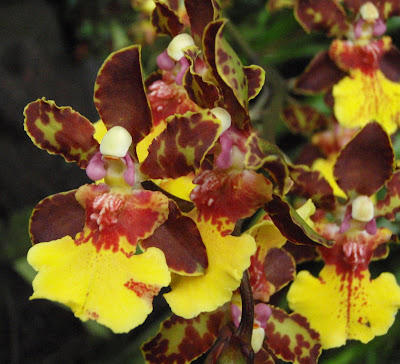Well, since i was at the National Orchid Gardens yesterday, it meant that i was at the Singapore Botanic Gardens (SBG) for a walk also. Here's the main gate you'll see if you approach SBG from Orchard road (picture below).
 First stop was the swan lake. I didn't saw any signboard to tell me that i was at swan lake but there was this (picture below). Now the swan lake do have swans living there right? Where are they....
First stop was the swan lake. I didn't saw any signboard to tell me that i was at swan lake but there was this (picture below). Now the swan lake do have swans living there right? Where are they.... Oh there they are (picture below). First 'discovery'!
Oh there they are (picture below). First 'discovery'! Discovery Note:
Discovery Note:1. Swans are large water birds that come from the same family which also includes geese and ducks.
2. Young swans are also known as cygnets. An adult male is a cob. An adult female is a pen.
3. Swans usually mate for life, though “divorce” does sometimes occur, particularly following nesting failure.
4. Swans are often a symbol of love or fidelity because of their long-lasting monogamous relationships.
And nearby to the lake was an art piece which caught my attention (picture below).
 This (picture above) is "Joy" by Ruth Bloch, donated by a friend of the Gardens, in celebration of Love, Life and Laughter in July 2005.
This (picture above) is "Joy" by Ruth Bloch, donated by a friend of the Gardens, in celebration of Love, Life and Laughter in July 2005.Second 'discovery' looks familiar, doesn't it? This is the emblem of the Singapore Botanic Gardens and is featured in their logo, the sealing-wax palm (picture below).
 Discovery Note (gathered from signboard in SBG):
Discovery Note (gathered from signboard in SBG):1. This striking clumping palm is native to the peat swamp forests of Malay Peninsula, Sumatra and Borneo.
2. The bright red crownshaft makes this palm unmistakeable and very attractive.
3. This plant is planted throughout the gardens.
Side note:
It was thought that this plant was not be to found growing in the wild anymore but if my memory serves me correct, a few months ago, the papers (Saturday Science section of the Straits Times) reported that people have found a wild and living sealing-wax palm in the forests of Singapore.
Third 'discovery' is the Jelawai, a designated heritage tree of Singapore (picture below). I didn't managed to take the whole tree in the photo as it was really too tall...
 Discovery Note (gathered from signboard in SBG):
Discovery Note (gathered from signboard in SBG):1. This Jelawai stands about 47 meters tall making it one of the tallest trees in SBG.
2. It is one of the giants of the rain forests of South-East Asia and is native to Singapore.
3. Once a year, the Jelawai will drop all its leaves and become briefly leafless before new leaves emerge.
4. Its two-winged fruits are dispersed by wind.
A familiar looking tree, the Kapok Tree was the fourth 'discovery' (picture below) Look at the contrast of height even when the lamp post in the picture is in the foreground. Wow!
 Discovery Note:
Discovery Note:1. This Kapok tree was planted in 1933. So that makes it to be at least 74 years old!
2. The Kapok tree is the tallest native tree in Africa, they can grow up to a height of exceeding 70 meters!
3. The brown seeds are round like peas and are found in pods.
4. The seed pods are woody, smooth and pendulous, with a light green colour. They will burst open while still on the tree after the leaves have fallen. Inside a whitish cotton like fiber surrounds the brown seeds.
5. These white cotton like fiber can be used in pillows and mattresses.
Side Note:
These trees actually play an important part within the ecosystem of the forest. Click here to find out more.
Fifth 'discovery' is the Tembusu (pictures below, it's the same tree by the way).

 Discovery Note (gathered from signboard in SBG):
Discovery Note (gathered from signboard in SBG):1. This Tembusu is probably the best known tree in Singapore as it is featured on the SGD$5 note.
2. No one knows when this tree was planted but it probably stood there even before the Garden was laid out in 1859. Wow! That makes this tree more than a hundred years old!
3. Tembusu is native to Singapore.
4. This very hard wooded tree can thrive even on very poor soils. And if left unpruned, the trees can often develop large low branches with upswept ends (as you see in the picture and the $5 note)
5. They bear creamy fragrant flowers that attract moths in the evening and their fruits are small orange berries.
On the tree trunk, i spotted this lighting strike recorder, the counter read "3" (picture below). I wonder if it means that this tree was struck by lighting thrice after this device was installed...
 But thankfully, this tree still looks healthy to me and hopefully will stay alive and healthy for many years to come. =)
But thankfully, this tree still looks healthy to me and hopefully will stay alive and healthy for many years to come. =)









































